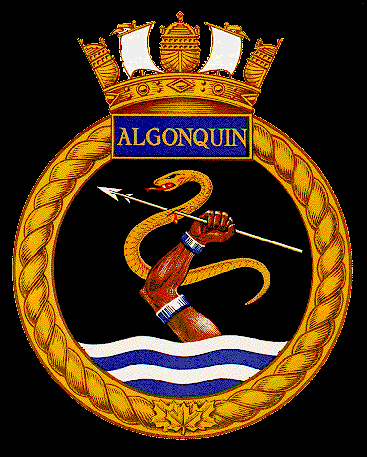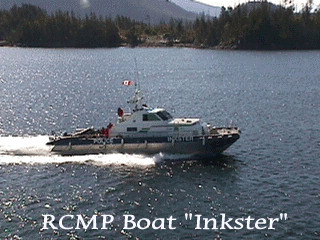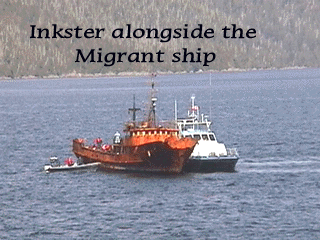 |
 |
|
 |
 |
|
My position onboard is the Combat Department Chief Petty Officer. This also includes a secondary duty called "Training Coordinator". The secondary duty seems to eat up more time than my primary job! Another duty I have onboard is the "Ethics Chief Petty Officer".
As the Combat Chief I am responsible for the training and welfare of approximately 80 personnel on the ship. This is the largest department onboard. I have only been in the job for three months now (June/99) but have so far found it to be the most challenging and rewarding position I have assumed during my career. It is very satisfying to be in a position where I can bring about change for the better for my people, as well as provide them the support they need to get their training, improve their quality of life and hopefully help them achieve their goals.
As the "Training Chief" I am responsible for the scheduling of all training which the ship requires to maintain all personnel at a state of high readiness. This includes First Aid, Fire Fighting, Flood Control, Small Arms training, Sea Survival, and the list goes on.
October 19,1999 I qualified as an Officer of the Day(OOD). This duty was formerly done only by officers. A few years ago it was decided that Chief's should also stand duty watches as OOD. You are responsible for the safety and security of the entire ship for the 24 hours you are duty. It is a thankless job and one that could have serious career implications if you make a mistake. Saying that, the qualification process involves a great deal of studying and you must pass an oral board headed by the Executive Officer. All the Department Heads are there and grill you for about an hour on all kinds of problems that you could encounter in your 24 hour period of duty. I am glad it is done and am able to put the studying behind me!
NOTEWORTHY EVENTS
28 Aug 99: It is with a great deal of sadness that I am adding this update to my website. Last week while at sea (24 Aug 99) we had a tragic accident. An aircraft (Russian MIG 21) that had been hired from Air USA, a company from Quincy Illinois that has purchased these aircraft to hire out for use in naval exercises, who was working with us, suddenly disappeared from our radars. Quickly, the ship attempted all means of contact with the pilot to no avail. The last known position of the plane was plotted ( approximately 17 nautical miles southwest of Estevan Point on Vancouver Island) and we headed at best speed to search for the pilot and his aircraft. Extra lookouts were posted, a passive sonar search was commenced and all radars and radio circuits were manned in the hopes that the pilot had merely gone astray. It was about one and a half hours into the search that we discovered the worst had occurred. The search went on for the next 36 hours and every bit of evidence found was taken aboard and later flown ashore by a search and rescue helicopter for analysis. The final conclusion was unfortunately that the pilot had in fact died. This is not the first time in my career that such a tragedy has occurred and although I pray it will be the last, it is an inherent reminder that what we do is very dangerous. A memorial service was held 02 Sep 99 for the pilot by the crew of Algonquin, in the location of the crash site. The pilot, Douglas Schultz, was a retired 30 year veteran of the United States Navy and reportedly the most experienced MIG pilot in the Western World. Sir, may God rest your soul, I hope you are in a better place now and at peace.
04 Sep 99: It was another exciting week at sea for Algonquin. As we headed out the Straits of Juan de Fuca (30 Aug 99), on our way to the "West Coast Firing Area" to start our Above Water Warfare Work-Ups we were tasked to assist Customs and Immigration Canada, the Canadian Coast Guard and the RCMP in the apprehension of the third boatload of Chinese immigrants attempting to land on our shores in the past month. Our Work-Ups were put on hold as we proceeded at best speed to the location of the "migrant boat". It was after dark when we arrived on the scene. The night was spent tracking the vessel awaiting further instructions from the Coast Guard who was the "On Scene Commander". Shortly after breakfast, the Coast Guard informed us that they would no longer require our assistance and they would be moving the immigrants to Gold River where they would be transported by bus to Victoria. The ship being released from the operation, began to head back towards the firing area to carry on with our Work Up program. It was not to much later that we were again called by the Coast Guard and asked to return to the scene as it appeared the migrants had attempted to scuttle their ship and it was sinking.
The ship turned about and began a flurry of preparations to deal with the situation. The damage control teams from the engineering department readied pumps and damage control equipment to save the distressed vessel. The first aid teams set up the hangar for a mass casualty evacuation. The deck department readied all the ships boats to evacuate the migrants and transport the damage control teams. The combat department set up it's intelligence gathering organization to record the events as they unfolded.


After arriving on the scene, ready to assist, it was determined that the initial report by the Coast Guard was in error and the boat was not sinking. Over a period of a couple hours, the female and children immigrants were transported to the Coast Guard ship Tanu. All the male immigrants were brought aboard Algonquin by the RCMP ship "Inkster", including the crew of the vessel who will be charged with smuggling. The one hundred and thirty plus men were all inspected for weapons, injuries etc and then put under guard in the hangar. They found this too hot and were moved out to the flight deck. They were given blankets and fed rice and liquids as we proceeded to Gold River where immigration officials and police were waiting with several buses. We stayed in Gold River only long enough to drop off the immigrants and then proceeded back to the firing area where we picked up our original training schedule and carried on to successfully complete our Work Up.


13 May 2000: Today the ship assumed "High Readiness" status and took over the duties of Flag Ship for the Canadian Pacific Fleet. We will now be home to the Commander Canadian Fleet Pacific, Commodore MacMillan. Ceremonial Divisions and a signing ceremony were held to mark the event. A great deal of preparation has gone into assuming high readiness and we are all glad that it is finally happened. Soon we will be off to the Far East and Hawaii for RIMPAC 2000. To follow the ship's progress over the next few months, go to the official home page of HMCS Algonquin!
FAR EAST/RIMPAC 2000 20 MAR - 10 JUL
This three and a half month deployment started with a "Directed Work-Ups" or DWUPS, which ended in sunny San Diego California. After a brief port visit, the Canadian Task Group set off to sea for "Task Group Work Ups" or TGWUPS to test the readiness of the Task Group as a whole, particularly the TG Commander and his staff. This was a new type of work up and from where I sat - it appeared to go quite well. On completion of TGWUPS, we dropped off the Sea Training Staff and started off for the next phase of the deployment, the Far East! The transit to the Far East was 21 days long. As soon as the ships got into calmer seas and fair weather, the painting parties took to the upper decks and the ships were "tiddlied" up in preparation for the upcoming port visits.
Far East deployments allow us to further relations with other countries governments and militaries, and are of great importance to the government. They are normally conducted every 2 years. This deployment consisted of HMCS Algonquin and HMCS Winnipeg. We visited Sendai Japan, Inchon Korea and Quindao China. These visits are quite busy as there are many receptions and tours that the sailors and officers must attend. There is very little time available for "rest and relaxation" although every sailor finds a way to get some down time! In the transits between ports the ships had the opportunity to conduct basic naval exercises with the host countries navy. Of historical note, the exercises conducted with the Peoples Republican Army Navy (PLAN) of China, were the first conducted with a Western Navy in over 50 years! Some other highlights of the Far East are:
Once the Far East portion of the deployment was completed, the two ships again headed out to sea for 18 days - this time to Hawaii, where we would meet up with other Canadian, US, UK, Australian, Chilaen, South Korean, and Japanese ships for the largest naval exercise conducted every other year, RIMPAC (Rim of the Pacific) 2000. The highlight of RIMPAC for the crew of Algonquin was the three live SM-2 missile firings we would conduct. I will be adding some short video clips of the missile firings soon!
After RIMPAC - the ships had a quick visit back to Hawaii and then started the transit home, where everyone started off on well deserved post deployment and summer leave. In September, my time at sea had once again come to a close and I was headed off to the Fleet School for a third time, as Senior Acoustic Instructor.
Go to the Official Homepage of HMCS Algonquin